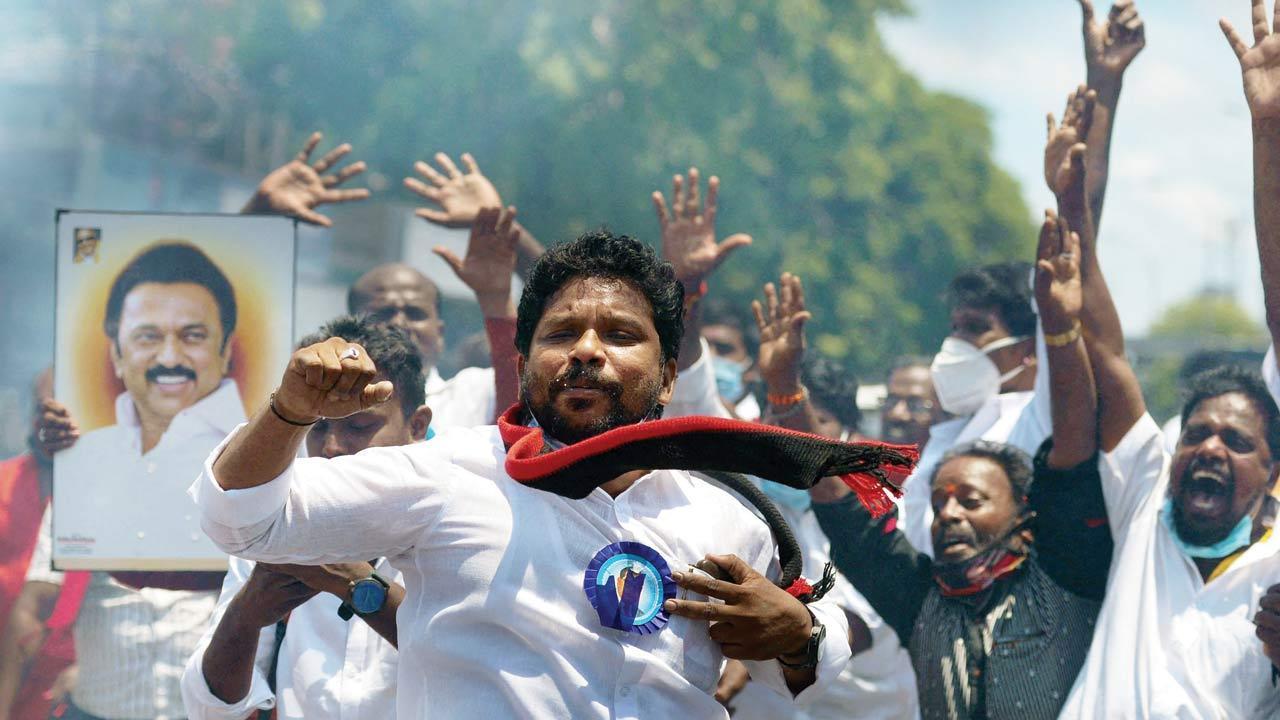While COVID-19 has taught the nation that elections and governance are serious business, Sunday’s results remind BJP of Hindutva’s limitations of subsuming regional identities anchored in language

Members of the Dravida Munnetra Kazhagam (DMK) party celebrate the results of the Tamil Nadu assembly elections at the party headquarters in Chennai on Sunday. Pic/AFP
For long, Prime Minister Narendra Modi occupied the proscenium of the Great Indian Theatre of Democracy, with his flowing beard, resembling an archetypical ancient sage or, as some thought, Rabindranath Tagore. Modi’s conduct was neither sage nor poet-like. He promised Asol Parivartan, or real change, for West Bengal, but also cat-called Mamata Banerjee with his “Didi-O-Didi” cry, and allowed his party to communalise the Assembly election campaign.
ADVERTISEMENT
On May 2, the ledger was tallied. The Bharatiya Janata Party failed to conquer West Bengal, retained Assam, and could not breach the South. Puducherry is a consolation victory, for it scarcely counts in the national election. These results will have even hardboiled BJP supporters agree that a month-long polling, perceived to have been scheduled at the Union government’s behest, had Modi take his eyes off the rising COVID-19 graph.
They will also know that the queues of bodies at crematoriums will have the Opposition to popularise the narrative that Modi led India into a viral apocalypse, as The Australian newspaper claimed. This is bad news for the BJP in Uttar Pradesh, where Chief Minister Adityanath’s yogic pretensions have not saved its populace from the ravages of COVID-19. They will unlikely forget their torment when, early next year, they elect a new Assembly for Uttar Pradesh, which sends 80 MPs to the Lok Sabha.
Losses in big states will put the skids under the BJP. Past trends show the party ruling Kolkata wins the largest chunk of West Bengal’s 42 Lok Sabha seats. On top of it, the DMK snatched the throne from the AIADMK, a BJP ally, in Tamil Nadu, which elects 39 MPs. The Left, Hindutva’s diehard ideological foe, defied history to retain power in Kerala, which has a kitty of 20 MPs.
The results underscore the limitation of Hindutva, a national politico-religious ideology, to subsume regional identities anchored in language. Against Banerjee’s campaign of insider versus outsider, the BJP offered development and Hindutva, which demonises Muslims for uniting the socially diverse Hindu community. Banerjee’s appeal to West Bengal’s exceptionalism, asking its voters to not let the State become a communal cauldron, triggered a secular consolidation. It saw the coming together of segments of the much-maligned bhadralok, or gentlefolk, with lower classes and castes, many of whom are beneficiaries of Banerjee’s welfare policies.
Hindutva has always coveted Tamil Nadu, where the BJP sought to project the DMK as anti-Hindu. It failed, not least because demonising Muslims seems a lie in a state where they are just six per cent. Muslims are also an element of the inclusive Dravidian identity, which is predicated upon subaltern assertion against the Brahminical-Sanskrit-Hindi imposition of the BJP. With the AIADMK performing better than expected, the BJP will find it hard to gobble up that party for masquerading as a significant political pole.
Hindutva’s strategy to communalise regional identity was successful in Assam, where the BJP overcame the fury over the Citizenship Amendment Act by portraying the alliance between the Congress and Badruddin Ajmal’s party as an invitation to Muslims from Bangladesh to flood the State. The BJP’s task was made easier as the Congress reneged on its promise of aligning with the two parties spawned by the social movement there, the Raijor Dal and the Assam Jatiya Parishad. Congress also lacks a local leader with spunk.
What must sting the Congress is its failure to wrest Kerala, where power alternates between the United Democratic Front that it leads and the ruling Left Democratic Front. A segment of the Congress could now switch to the BJP, which has been attracting the upper-caste base of the former. It was to appease the conservative upper castes that the Congress soft-pedalled on Hindutva — and lost a percentage of minority and progressive votes. By contrast, Chief Minister Pinarayi Vijayan forged a social coalition of the Other Backward Classes, Dalits, Muslims and Christians, evident from the allocation of party tickets.
The Congress has become a worry for the Opposition. From 1989 to 2019, as independent researcher Vignesh Karthik KR has shown, regional parties together accounted for 44 per cent or more of the national vote-share in the Lok Sabha elections. During the same period, the Congress’s share plummeted from 40 per cent to 19 per cent, and the BJP’s grew from 11 per cent to 37 per cent. These figures show the BJP’s rise has been at the expense of the Congress, which has more or less lost its upper caste base to its national rival.
The upper caste leadership of the Congress needs to acquire a more subaltern identity. Or it should strive to win its erstwhile middle class-upper caste supporters, whose privileges could not shield them from the misery arising out of the mishandling of the COVID-19 crisis. Rahul Gandhi must grow from being the nation’s conscience-keeper to an Opposition leader whose politics is successful beyond Twitter.
As for the prime minister, it is time he sheared his beard before he steps again into the proscenium of the Great Indian Theatre of Democracy, for COVID-19 has taught the nation that elections and governance are serious business, not just a drama for entertaining and communalising Indians. His beard, unfortunately, has come to symbolise precisely that.
The writer is a senior journalist. Send your feedback to mailbag@mid-day.com
The views expressed in this column are the individual’s and don’t represent those of the paper.
 Subscribe today by clicking the link and stay updated with the latest news!" Click here!
Subscribe today by clicking the link and stay updated with the latest news!" Click here!






